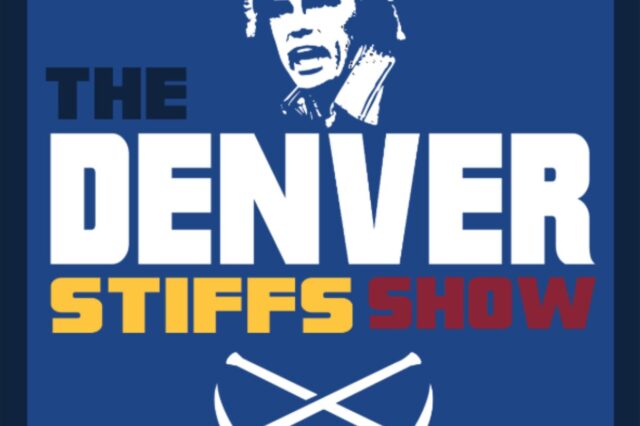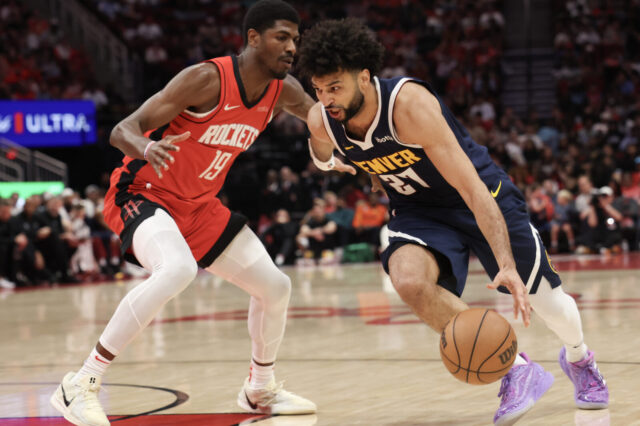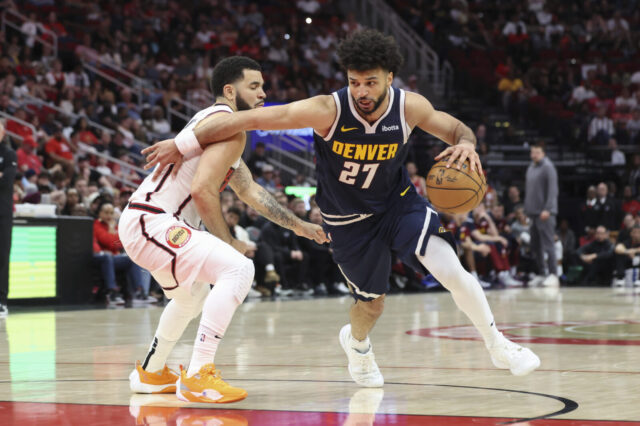In this week’s edition of Starting Five:
- MPJ doing more than just scoring
- Jamal Murray, battered but not beaten
- Gary Harris and Will Barton hoping to find consistency
- PJ Dozier’s biggest improvement area on defense
- Nikola Jokić acting like LeBron in the best way
Let’s dive in:
What Michael Porter Jr. adds when he isn’t scoring
On Saturday night, following his 35-minute performance playing 26 of the final 28 minutes of the second half and both overtime periods, Michael Porter Jr. shared an impressive quote following a good question from Harrison Wind of DNVR:
Porter has received criticism for most of his young career for being a one dimensional player. His defense leaves plenty to be desired. His playmaking for others is often a step slow or nothing at all. He’s still young and inexperienced, and though he can change those things with time, the criticisms of his all-around game are still warranted.
That doesn’t mean he can’t be helpful though, and his games over the weekend against the Phoenix Suns were a good way to prove that. A few ways he contributed that aren’t sexy and won’t show up on the highlight reels (unlike that sweet, sweet jump shot) are his rebounding on both ends of the floor and athleticism on the defensive end.
Here’s a possession where Porter, a feared offensive rebounder, draws enough attention from Jevon Carter to leave the middle of the floor open for Nikola Jokić to rebound and top in a miss easily.
Having Porter and Jokić on the floor and attacking the offensive glass is certifiably unfair against a team like the Suns that struggled with a lack of interior size when Deandre Ayton sat. The two Nuggets combined for 33 total rebounds, including nine offensive rebounds that helped the Nuggets offense hang around despite an inefficient offensive night overall.
Porter draws attention on the offensive glass even when he’s outside the paint too.
Abdel Nader is forced to face guard Porter in this situation as he doesn’t know whether Porter will cut to receive a pass or move to offensive rebounding position. Nader is petrified here, despite Porter having come into the game roughly 20 seconds prior. This allows JaMychal Green to sneak in and around the middle of the floor unabated, only having to fend off rookie Jalen Smith before an offensive rebounded miraculous and-1 drops gracefully through the net.
Porter also grabbed defensive rebounds at a high rate, placing himself in great low position against Ayton at the beginning of clutch time and grabbing a physical rebound on this possession.
The worry with Porter as the low man on weak side pick and roll defense is whether the second year player can process quickly enough to be impactful. I wonder how Porter would have reacted had Paul attempted to throw a pass to Porter’s man (Abdel Nader) in the corner; however, Porter takes a good angle in cutting off Ayton’s roll attempt and doesn’t give Paul a great option either way because of how early he reacts, despite moving relatively slowly. This would have put him in good position to steal a cross court pass had he seen it and reacted quickly enough.
Here’s another good example of Porter’s weak side defense in a more traditional sense:
Porter’s responsibility changes from strong side to weak side the moment Carter swings the ball to Nader, but it’s still good to see Porter recognize that reality and make a play on the ball. Could Nader have created an open shot by passing it to the corner Porter just vacated? Probably, but it’s hard to make that read while driving with his head in Monte Morris’ chest. Porter takes advantage, blocks the shot athletically to his teammate, and is rewarded for his efforts with a three-pointer, courtesy of Jamal Murray.
It’s unclear whether Porter will move into the starting lineup over the course of this road trip, but he showed enough on both sides of the ball outside of his scoring that I do expect it to happen at some point. It’s notable that most of Porter’s success came as a power forward next to either Green or Jokić, and though he’d likely reenter the starting unit as a small forward, Michael Malone and the coaching staff should attempt to find time for him as the power forward on the second unit and in clutch situations. This is Denver’s best form currently and allows them to maximize a guard heavy roster.
Jamal Murray gutting out difficult minutes
Weeks like the last one are why Nuggets fans have complicated feelings for Jamal Murray playing hurt. On Tuesday against the Oklahoma City Thunder, Murray played just 20:35, shooting 2-of-10 from the field and mostly struggling on both sides of the floor against the added attention of Luguentz Dort and Shai Gilgeous-Alexander. He left the game early due to a nosebleed (I think?) and didn’t have to return as the same starting unit got things together with the steady Monte Morris leading the way.
Then, against the Phoenix Suns on a back-to-back in two separate games that went to overtime and double overtime respectively, Murray hit several clutch shots to propel the Nuggets to two wins they needed desperately.
The first was extremely notable. It came against Mikal Bridges with the Nuggets up one in overtime. Murray navigated the pick and roll expertly, realized the easiest shot to be created would be a mid-range pull-up, and drove right to the spot he needed to drive to free up space against a great perimeter defender. It was smooth, purposeful, and effective with Murray simply taking what the defense gave him and confidently hitting the minimally open shot.
The second shot attempt was the most impressive.
Isolated against Deandre Ayton on the perimeter and needing a three, Murray drove to his left, putting him in a comfortable spot to step back and get off a clean shot attempt. Did he travel? by the letter of the law, yes, but who cares? This shot attempt was incredibly gutsy and clutch, giving Denver life in a game they had nearly thrown away after several uncharacteristically bad possessions from Jokić in the fourth quarter. Murray saved Denver’s bacon and gave them life.
The last was similar to the first shot, coming against the same defender and in the same general place on the floor, created in a different way.
Murray rejects the high screen by Jokić, catching Bridges off guard and gaining a step initially. Rather than drive hard to the rim, Murray waits patiently for Bridges to recover, then steps back and away from a defender tailing him the entire way, calmly hitting another open mid-range jumper. Could Murray have put more pressure on Frank Kaminsky as the only rim protector? Maybe, but this shot attempt was cleaner and eliminated the possibility of a turnover and empty possession.
Murray wasn’t the most efficient contributor over the weekend, but like the bubble playoffs, he was the most gutsy. Playing 40 and 43 minutes on a back-to-back with several ailments, including a sore left shoulder that placed him on the injury report on Saturday, Murray appeared exhausted after the Nuggets finally came away with their second victory in two nights. Denver needed them badly and Murray, the warrior that he is, provided in earnest.
Gary Harris and Will Barton offer signs of improvement
Though Denver’s two starting wings (sans Porter) have been up and down throughout the year, the Nuggets had a rare game on Friday night where both Gary Harris and Will Barton played well at the same time. Scoring 36 points on 22 shots and closing out the game at small forward and power forward respectively helped the Nuggets earn a win against a good opponent. Harris and Barton each drove confidently to the rim against a porous Suns interior defense, punishing the home team for sticking too closely to actions featuring Jokić and Murray.
This shot in particular was impressive from Harris, going up against the length of Cameron Johnson (6’9”) and Mikal Bridges (6’7”). One steadfast part of Harris’ game this season (apart from perimeter defense) has been his finishing in the restricted area. Among the 46 guards with at least 45 attempts in the restricted area, Harris ranks seventh in efficiency, shooting 67.4 FG%. Murray actually ranks tied for eighth at 66.7 FG%, while Barton ranks 26th at 59.2 FG%.
Barton, though he hasn’t been as efficient, found a way to draw some fouls late in the game on Friday night and convert points at the free throw line. He did get a nice bucket to go late on Friday off a drive to the rim, finishing past Cameron Payne and over Bridges for a clutch layup to give the Nuggets the lead late that they wouldn’t relinquish.
The most difficult part about the seasons for Harris and Barton to date have been the consistency. The two have averaged a combined 22.1 points on below average efficiency thus far, but they have each combined for double figure point totals just six times on the year and have actually combined for single digit point totals three times. Combined with Paul Millsap’s relative step back in terms of minutes and role, the production the Nuggets had come to expect from their surrounding veterans has shifted drastically.
The Nuggets are a more dangerous team when they have multiple threats on the wing around what Jokić and Murray do consistently. Harris and Barton have been more consistent lately, but it’s still something the pair struggle with. If they could string some consistent performances together on the rest of the road trip, that would go a long way in helping Denver bank some wins early.
PJ Dozier is defending the three-point line badly
This is great defense from PJ Dozier, who can only congratulate Jevon Carter on a good shot at the buzzer.
Carter, now shooting 27.5% from three-point range, is not a player one would associate with hitting tough, contested threes at the buzzer. More often than not, Carter’s the player who defends those shot attempts.
Here’s another shot attempt that Dozier just can’t do much about. He’s a good defender! I promise.
Devin Booker is a tough cover for anyone, and while Dozier didn’t do himself any favors in falling behind the play, he recovered well and used his length to contest a shot (Porter probably could have blocked this). Instead, the shot drops through the net, leaving Dozier pretty frustrated.
According to NBA.com, players are shooting 50.4% from the field when guarded by Dozier so far this year, 5.2% higher than they should be shooting on similar shot attempts. Most of this difference has come from behind the three-point line, where opposing shooters have converted 46.3% of their threes when guarded by Dozier, nearly 10% higher than the average conversion rate and the ninth highest differential among all players to defend at least 40 three-pointers.
Here’s one example:
Was this a remarkable pass by Luka Doncic? Sure. Was it bad defense by Dozier? Absolutely. If Dozier is going to rotate as the low man in pick and roll coverage, he has to do so way earlier than this. Doncic catches him moving in one direction while already passing the ball to the player he’s vacating.
This is a weakness in Denver’s defensive scheme with Nikola Jokić playing up at the level of the screen or even hedging. Barton also struggles as the low man on the weak side while Millsap is quickly losing his reaction time on those plays. Dozier has to be the best at this on the team if he wants to be a prominent part of the rotation, and while he does a good job at some points, he struggles at others times. He tries to do too much and leaves his own man open as a result.
If he can strike a better balance between helping and not helping, Denver may have to find even more time for him.
Nikola Jokić putting an end to the Suns in double overtime
Jokić was done with the Suns. Multiple overtime periods across multiple games. he struggled in the fourth quarter and overtime before stringing together four straight possessions in double overtime in which he scored or assisted on all of them.
The first possession saw him hit a cutting Monte Morris following a post entry pass, taking advantage of an inexperienced Abdel Nader who lost Morris on a cut. That’s basically daring Jokić to demoralize a defense.
The second possession involved him drawing a double team and making the easiest cross-court pass of his career to a wide open Morris for three.
The third possession involved an isolation from Jokić at the top of the key against a shorter, less athletic defender in Kaminsky, who probably should have recognized the short shot clock but gave Jokić plenty of space to shoot a mid-range jumper. That’s what constantly posting up and passing out of double teams will do.
The fourth possession has sort of become a Jokić signature against a smaller post defender in single coverage on the left block. He catches the ball, leverages his weight, patiently backs his way to the front of the rim, and finishes with a post hook.
This is what a superstar offensive player can do. Four possessions, four scores in four distinctly different ways. Lose focus for a split second and Jokić finds a seam for a quick layup. Double team him on the block and he patiently waits for the open passing opportunity. Don’t respect his jump shot and he can calmly hit one with the shot clock winding down. Don’t double team him on the block and he can punish a mismatch.
The evolution of Jokić’s thought process in these situations is eerily similar to LeBron James. Jokić obviously doesn’t have the legendary athleticism that puts LeBron in the pantheon for the GOAT debate, but he might have everything else, capped off by an incredible mind for the game and passing instincts designed to prey upon a defense’s greatest weaknesses. It’s why Jokić remains in the MVP conversation despite a slower start to the season for the Nuggets as a whole. Jokić has been individually dominant in an NBA that has quickly run out of superlatives for the ways he can affect the game as a point center, and it’s Denver’s greatest advantage in their pursuit of a championship. As Jokić continues to learn new ways of leveraging a defense, he’s going to be putting entire teams in the torture chamber for a long, long time.


